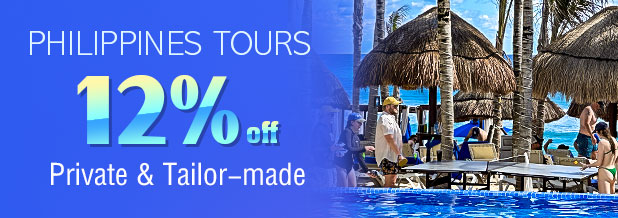Philippines Travel Guide
Basic Facts of Philippines
Location: Southeast Asia
Area: about 115,715 square mi (299,700 square km)
Population: about 103 million
Language: Filipino and English
Currency: Peso
Time Zone: UTC+8
Capital: Manila
Administrative Division: 17 regions and 81 provinces
Religions and Beliefs: Catholicism, Islam and Protestantism
Top Things to Do in Philippines
As an archipelagic country, the Philippines has a reputation of the pearl on the Western Pacific Ocean with more than 7,000 islands dotted in the ocean. Some of them are volcanic islands, some are lagoon islands and some are coral islands with colorful and beautiful scenery. The sun, sand beaches, the sea wave and tropical plants are integrated perfectly in Philippines, where you can appreciate architecture in various styles, dive freely, enjoy the sunlight and taste mouth-watering delicacies and succulent fruits.
Top Destinations & Attractions:
Manila: San Agustin Church, Manila Cathedral, Intramuros, University of Santo Tomas
Boracay: White Beach, Puka Beach, Friday Beach, Willy's Rock, Mount Luho
Cebu: Basilica Minore del Santo Nino, Magellan's Cross, Fort San Pedro
Bohol Island: Chocolate Hills, Virgin Island, Tarsier Visitors Center
Puerto Galera: Sabang Beach
Best Time to Visit Philippines
Tourists can visit Philippines at any time of the year, but generally December to February is the best time to visit as the weather is pleasantly cool with mild temperature and little rain. Rainfall is mainly concentrated between June and September. It may rain in the morning, or at noon or dusk, and the rain will not last too long. March to May is dry season with relatively high temperature. However, the number of tourists is small in dry and rain seasons, so accommodation is relatively cheaper.
Transportation
Rail transportation is less developed in Philippines, and the main railway networks are the light rail transit system in Manila. Water transportation in the country is well-developed with a total length of 3,219 km (2,000 mi), and Manila, Cebu, Iloilo and Zamboanga are the main ports among the hundreds of ports. There are more than 280 airports in Philippines, and domestic flights are operated among over 40 cities. Ninoy Aquino International Airport in Manila is the main gateway of the country. Land transportation also dominates the transportation system, which carries over 90% of the total transport volume. You can travel among cities by bus. Jeepney, banca and motor tricycle are unique modes of transportation, which are worth experiencing.
Philippines Travel Tips
Tourists can apply to the Philippines Embassy for visas before traveling there or get visas on arrival. Most regions in the country are safe, but kidnappings, bombings and other violent incidents are frequent in Southern region especially in Mindanao area, so you should carefully select your travel destinations. Most Filipinos hold religious beliefs, so you should respect their faith and pay attention to your words and behaviors. It is a taboo to pass objects or grab food by your left hand, because the locals think left hands are dirty and degrading. Tips are very much expected in Philippines, but coins are taboo when you give tips face to face. In addition, you'd better take anti-seasickness medicine.
History
The ancestors of Filipinos are immigrants from the Asian continent. Around the 14th century AD, many separatist regimes were established by native tribes and Malay immigrants, among which the Sultanate of Sulu was the most famous regime established in 1370s. It was invaded and ruled for over 300 years by Spanish after 1565, and was occupied by the US in 1898 and Japan in 1942. After World War II, it was recolonized by the US and got independence in 1946. Nowadays, Intramuros, Fort Santiago and the Historic Town of Vigan are symbols of its history.
Geographical Features
Mountainous topography accounts for more than three fourths of the total area and over 200 volcanoes spread in Philippines. Among all volcanoes, 21 volcanoes are active. The Mayon Volcano is the biggest active volcano in the country, which is a famous scenic spot in Philippines and can be comparable with Mount Fuji in Japan. The vast maritime waters and diverse marine life can easily form coral reefs. Tubbataha Reef in the Sulu Sea is a popular attraction and a sanctuary for a variety of fishes and hawksbill turtles, where you can dive and see colorful fishes.

